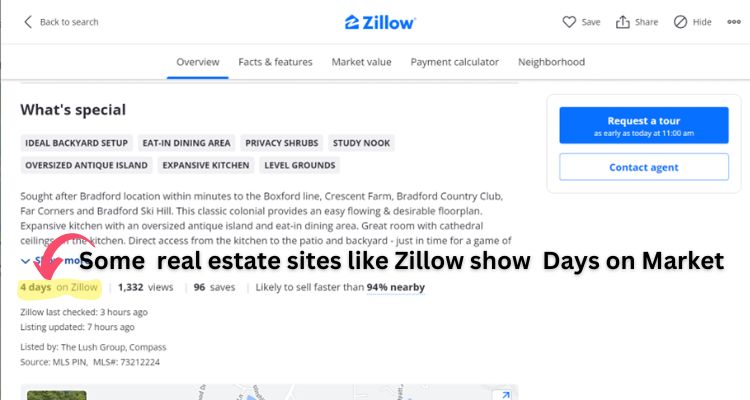 You will hear the two terms used synonymously: Days on Market (DOM) or Market Time. It is the number of days your house is marketed before the home is put under agreement.
You will hear the two terms used synonymously: Days on Market (DOM) or Market Time. It is the number of days your house is marketed before the home is put under agreement.
If you list your home on July 1st and do not receive an offer until September 15th, you will have 76 days on the market or 76 days on the market time.
DOM is a metric that real estate agents use to gauge the state of the real estate market. It provides insights into how long properties typically stay on the market before being sold. This information helps agents advise their clients on pricing strategies, timing for listing their homes, and expectations regarding the sale process.
Additionally, it can be a crucial indicator for understanding market trends, determining whether it’s a buyer’s or seller’s market, and identifying shifts in market dynamics.
Jump To A Section....
What Is Days On Market?
As pointed out in the intro, Days on Market (DOM) or market time is a real estate metric that measures the number of days a property is listed for sale until is taken off the market and marked as under agreement. The property is no longer an active listing in the MLS and is no longer being shown to prospective buyers.
The Impact Of Market Times On The Real Estate Market
DOM is not just a random number. It is an essential indicator used by real estate professionals, home buyers, and sellers to understand different market dynamics, such as the demand for properties and the pace at which homes sell.
A lower average DOM typically indicates a seller’s market with high demand and fast-moving properties. In 2024, we see unprecedented low days on the market, indicating a high buyer demand.
A higher average DOM suggests a buyer’s market where properties tend to linger longer due to lower demand.
This metric helps set pricing strategies, negotiate sales, and understand market trends.
Example of Market Times, Haverhill MA
For example, the Haverhill, MA, real estate market encompassing single-family homes, multi-family homes, and condominiums has had a market time of 28 days over the past three months. During the same time period in 2018, the market time was 72 days. This is almost three times longer, yet still a healthy market.
Over the past 20 years, the average number of days on the market in Haverhill has been 77 days.
Days on Market Analysis for Haverhill
I decided to track the sold homes in Haverhill, MA, through the Massachusetts MLS. The Market Time analysis covers all the homes for sale in Haverhill over 10 years. While I used the Haverhill MA Real Estate market for the analysis, you will find a similar pattern no matter what region you looked in.
| Days on Market | Percentage of Sold to List Price | Median Sold Price |
| 0-25 DOM | $350,000 | |
| 25-50 DOM | $310,00 | |
| 50-100 DOM | $285,000 | |
| 100-200 DOM | $275,000 | |

The Benefits Of A Low Market Times for Home Sellers
Higher Selling Price
The analysis shows that there is clearly a distinction between how long your home sits unsold and getting top dollar for it. Often, if you can sell your house in under 3-4 weeks, you will receive the maximum return possible.
Why Is That?
You may wonder why that is the case, and you will often find that your first offer or two will be your best offer. And there is an excellent explanation. There are two things in play here.
The first is excitement for your home is highest when it hits the market as a new listing. That excitement comes from buyers who have been out in the marketplace for months, have felt some pain, and are ready to buy. These are your best, most motivated buyers.
Second, buyers have a herd mentality. They don’t want a house no one else wants. As your home sits on the market and pushes past average market time, buyers wonder why no one has bought it. What’s wrong with it?
If no one else wants it, why would I?
Other Benefits of Low Market Times
We discussed the financial benefits of keeping your market times under 3-4 weeks. But home sellers will reap other benefits.
Less Stress
Imagine getting your home sold in the first ten days of hitting the MLS. Let’s face it: selling your home is work. Now you don’t have to prepare for endless showings, pack up the family for open houses and you can concentrate on your next move.
Ten days vs. ninety days of showings, what would you rather?
Stronger Negotiating Position
Buyers are very educated on the market. They know that when they see a good home and if the house is new to the market, they may have to compete with other buyers to get your home. If you get an offer early on in the listing process, buyers know you aren’t budging off your asking price. And they don’t want to lose the house to another buyer.
And, competing offers are great for negotiating.
More Attractive to Buyers
When your house is new to the market, it will attract more interest from buyers. It’s new and exciting and a fresh opportunity. Buyer activity is at its highest in the first week or two. Buyers want their choices validated. If it’s popular with other buyers, it confirms their feeling that the home is a good value.
Avoid A Stale Listing
A home that sits on the market is like a banana. You first bring it home it’s the perfect color with no blemishes. As time goes on, the peel starts to turn brown, and dark spots show up. This is precisely how a buyer views a home as it sits on the market unsold. It is important to monitor the market and be pro-active with price reductions if need be.
Eventually, a stale listing will sell for less than its true market value as shown in our analysis above.
How Can Sellers Control How Long Their Home Sits On The Market?
There are a few things that a home seller can do to sell their home quickly and avoid above-average days being actively listed. But several stand out:
Pricing Correctly
Pricing your house right at market value or slightly under will produce the results you are looking for. Think of it this way. A home buyer finds a house compelling because they believe it is a good value for what they seek.
A house priced at $600k may not compete well with other homes in that price range. It’s lacking and not compelling to a buyer. But, that same house at $550k can now be seen as a good value based on the home’s competition. Buyers will now find it compelling all because it is priced correctly.
Preparation Of The Home
Buyers love move-in-ready and attractive homes. Spending a little time on minor nuisance repairs, improving curb appeal, and staging the interior will reap financial benefits and speed up the sale.
Take some time to make your house visually compelling, then price it right, and you will have a quick sale with a maximum return from the net proceeds.
Provide Superior Marketing
You can have the best house in town, but if no one knows how great it is, it won’t sell. Poor marketing can make your home linger on the market. Your home needs top-notch aggressive marketing.
A top-producing agent should provide professional real estate photos, drone photography, video, and floor plans for your home. Then, it must be pushed out to the general public through various marketing channels, including the MLS, social media and more.
If your agent pulls out a cell phone camera and snaps a few photos, you know you’re in trouble. Selling a home requires a carefully executed marketing plan.
Insight For Home Buyers Regarding Days On Market
The DOM metric is not just for home sellers. It is an indicator a home buyer should consider as well. Days on market can significantly influence a buyer’s purchase decision as well as something to consider while structuring an offer.
- Market Temperature Indicator: DOM is a real estate market thermometer. A low DOM typically indicates a hot market where properties sell quickly, often leading to competitive bidding scenarios. Conversely, a high DOM suggests a cooler market where properties linger longer, potentially giving buyers more negotiation leverage. Market conditions shape how a buyer spends their time in the market.
- Negotiation Leverage: Properties with a prolonged DOM may present an opportunity for negotiation. Sellers of such properties might be more willing to consider lower offers, include additional incentives, or agree to terms that are more favorable to the buyer. It signals that there might be room to negotiate on price or terms.
- Assess Property Appeal: A high DOM could imply issues with the property itself, such as pricing, condition, or less desirable features. Buyers should use DOM as a prompt to do a little more digging on the property. Like asking questions about why the property hasn’t sold and whether those reasons impact the buyer’s interest or offer strategy.
- Understand Pricing Dynamics: DOM can offer insights into the pricing dynamics of a market or neighborhood. Properties with consistently low DOMs in an area might indicate a highly desirable location where pricing might be more aggressive. On the other hand, higher DOMs can signal areas where buyers might find more value or opportunities to negotiate better deals.
- Evaluate Market Trends: For buyers looking to purchase in a specific area, tracking the DOM trends over time can provide valuable insights into how the market is shifting. Increasing DOMs might indicate a slowing market, potentially signaling a good time to buy. Decreasing DOMs suggests a market heating up, where acting swiftly might be necessary to secure a desirable property.
- Condition and Desirability: A property’s DOM sometimes reflects its condition or desirability. A low DOM can indicate a property that meets buyers’ expectations regarding location, condition, and price. High DOM properties might require more scrutiny to assess if specific reasons deter buyers, such as needed repairs or undesirable location factors.
Days On Market can give a home buyer quite a few indications, and it is something that should be considered. For example, if average market times for similar homes are 30 days, but you run across a home that has been on for 100 days, it requires taking a deeper look.
- Is there something physically wrong with the property?
- Is it an undesirable neighborhood or location?
- Would most buyers find it unappealing?
- Is it priced too high?
- May the REALTOR or Owner be hindering the sale?
- Poor Marketing
- Lack of Information
- Is the seller not allowing showings?
- And more….
DOM Is An Important Indicator For REALTORS
Market Time is a critical metric for your Massachusetts REALTOR. It offers a lens through which they can gauge the temperature of the real estate market, making it indispensable when advising both buyers and sellers.
A REALTOR or agent, representing the buyer or the seller, should present a comparative market analysis that indicates the days on the market for comparable homes to the one you are selling or a buyer contemplating putting in an offer. With your REALTOR’s guidance and information, you can make informed decisions.
Real estate markets are fickle. They can turn on a dime based on many outside influences, including the economy, interest rates as we have recently seen, world events and more.
DOM is a strong indicator that helps REALTORS identify trends in the real estate market, allowing them to offer strategic advice based on local market dynamics. For example, an increasing average DOM in a specific area might indicate a cooling market, where buyers could find more favorable conditions.
For example, if days on the market have increased over six months, the market is cooling. When the market cools, inventory rises. As a seller, your house will have more homes to compete with, and buyers will have more homes to choose from.
As a REALTOR working with a seller, I would advise you not to be too aggressive on pricing and emphasize the importance of preparing your home and strong showing principles to stand out from the competition.
A cooling market provides more opportunities for buyers: more homes to choose from and more opportunities to negotiate. As a REALTOR, I would strategize differently with my buyers on how we look for homes and take a more aggressive stance for my buyers in negotiations.
Where Do I Find Market Times?
Finding out how long a home has been on the market for actively listed homes is simple. Many websites, like REALTOR.com or Zillow, have a property history showing when the property was listed. Others, including Zillow, will show how long a property has been on the market.
Once a property becomes off-market, the data is challenging to find. In this case, you must rely on your REALTOR for this information. Note that days on market vary significantly from day to a close. Days to close is not a valuable indicator.

Days on Market Vs. Days To Offer
The Massachusetts Multiple Listing Service offers two similar metrics: days to market and days to offer. While days to market measure the period between the listing going active and coming off the market, days to offer represents the period from when the home is listed to when an offer is accepted.
A home may stay active after an offer is accepted for various reasons. The offer may be contingent, or additional paperwork may need to be signed. Typically, there is about a 7-14 day lag time between days to offer and days on the market.
My preference is to use the days to offer metric. I feel it better represents what is going on. But days on market is the more commonly used indicator nationwide. Just be consistent in which one you use.
What is Days on Market (DOM) in real estate?
Why is DOM important for buyers and sellers?
Does a low DOM always mean it's a seller's market?
Can DOM vary by season?
Is DOM a good indicator of the real estate climate in my area?
Can DOM affect a buyer's perception of a property?
Conclusion
DOM is like a stopwatch for selling houses. It starts when a house is up for sale and stops when the property is taken of the market. If the stopwatch runs for a short time (low DOM), houses are selling fast, and it’s a good sign for sellers. If it takes longer (high DOM), buyers might get a better deal because the house has been waiting for someone to buy it.
Real estate agents look at days on the market to help decide how to price a house, advise buyers and sellers on when to move, and negotiate an offer.
It’s an important metric for everyone in a real estate transaction and plays a large role in the decision making process for everyone involved

Author Bio
Kevin Vitali is a Massachusetts REALTOR out of Haverhill MA that serves Essex County and Northern Middlesex County in Massachusetts. If you want to buy or sell a home, let me use my years of experience to get you the best possible outcome.
Feel free to contact me to discuss any upcoming moves. I am always happy to answer your questions
Call 978-360-0422 Email kevin@kevinvitali.com






